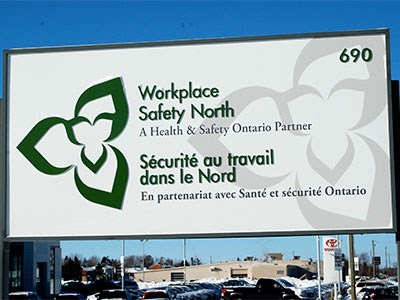Workplace Safety North (WSN) may be operating behind the scenes, but it works diligently to ensure workers go home safe each day.
Based out of North Bay, it is the amalgamation of three former associations that merged three years ago – Mines and Aggregates Safety and Health Association (MASHA), Ontario Forestry Safe Workplace Association (OFSWA), and Pulp and Paper Health and Safety Association (PPHSA). All were operating in the same building.
“With WSN, we are not as easily identifiable since a lot of people still identify us with our legacy organizations. But, we are getting traction and that is a great progress report for us,” said Candys Ballanger-Michaud, president and CEO of WSN.
There were 12 health and safety associations across the province, and they were grouped into four. WSN is currently the only health and safety association that has its head office based in the North. All others are based in southern Ontario.
“When the amalgamation came about, we were asked to take on a greater Northern mandate,” she said. “In some cases, we are the only service provider in some of the communities in the North. However, our sister associations do have services in the North.”
Most of the pulp and paper clients are in the south, while mining and forestry remain concentrated in the North, and WSN still has a mandate to support its legacy clients. Most of the funding comes from employers from those three sectors.
“A percentage of the WSIB (Workers Safety Insurance Board) premiums that they pay actually come to us, to provide them with health and safety solutions to help them develop the skills and knowledge they need in their workplace to ensure workers remain safe,” Ballanger-Michaud said.
“Really, at the heart of what we do, is safety training and auditing, consulting and how we can help workplaces improve organizationally in all matters relating to safety and prevention.”
It’s important to listen to their clients, to know what their needs are, in order to respond to them.
“We have industry advisory committees that help to inform us, we do surveys of our clients, and we do research to stay on top of current trends,” she said.
WSN uses webinars to communicate with its clients, which is a free service. For instance, if the Ministry of Labour is planning a blitz, WSN will inform its clients of what that will entail through a webinar. Non-members, defined by those not paying WSIB premiums, can also take advantage of WSN’s services.
“Webinars are free, but we do have other services at a fee, and it is to simply break even. If a company is not paying into WSIB, we have a separate price. We don’t believe the employers paying into the system should subsidize those who are not,” said Ballanger-Michaud.
The association has more than 70 employees, but not all are based in North Bay. About 25 health and safety professionals are located throughout the province serving various communities.
The world-renowned Ontario Mine Rescue falls under the jurisdiction of WSN.
There are 875 volunteers, who are miners across Ontario.
“Their day jobs are miners, and the companies they work for support these individuals to be trained, so if there is an emergency underground, they would be prepared to respond to it,” she said.
“We have an entire team that is dispersed across the province that provides that emergency preparedness training to the various miners. We have 11 mine rescue officers and their operations are based out of Sudbury.”
Client companies can approach WSN to find out what they need in the area of health and safety. Assessments can be done to ensure they are at least in compliance with the legislation.
As a champion of health and safety, WSN also does exercises such as mock trials. One was held in Timmins in 2011, and attracted 270 participants.
“If you ever ended up in a situation where you needed to go court, this is what you would expect,” she said.
“We do offer a great deal and focus our efforts on what is happening and where those injuries are taking place and the types of hazards that places are faced with so we try to customize it to make sure it is relevant to the workplaces we serve.”




